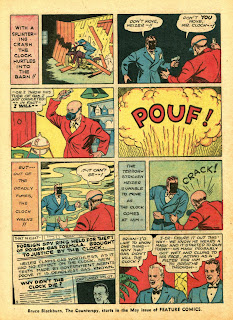I'm a big fan of DC Comics characters as well as Golden Age comics. I thought buying all three of these DC "War Years" books would make me happy. Well, they sort of did and sort of didn't. Actually, the store I saw these in only had the Batman and Wonder Woman books. As much as I wanted the Superman book the most (Superman is my all-time favorite comic book hero), maybe I should just spring for the DC Archive Editions of his books instead of tracking down a copy of the Superman "War Years" book. Let me tell you why.
The books feature new commentary by Roy Thomas, one of my favorite comic book writers. Roy gives a brief account of what was going on in the world at the time the original comics were published, which was 1938 to 1945. He then gives the reader a brief comment on the stories you are about to read. So far, so good. But then we see the pages of the stories, and sometimes even the covers, and this is where the books fail. All four sides of several covers and pages are cropped off for no apparent reason. This means words, artists' signatures and art alike are sliced off. This makes it hard to read the captions and dialogue on certain pages.
If you have the Batman book, for example, turn to page 267. Read panel five. What the dialogue says, in my copy at least, is "By the time the firemen get her Batman's goos will be cooked --- to a crisp!" I'm fairly certain that the dialogue should read "By the time the firemen get here Batman's goose will be cooked --- to a crisp!" If you have the book "Batman Archives Volume 1" you can see a better looking version of the cover for "Detective Comics" #38, the debut of Robin, the Boy Wonder. Having said this, "Batman - The War Years 1939 - 1945" does improve upon the Archive book in one case: the first Batman story from "Detective Comics" #27 is the original version with a bloody knife intact. It is also colored and lettered differently.
"Wonder Woman - The War Years 1941 - 1945" has the same problems with art and words cut off. There's even proof of this in the book itself! Page 124 shows the cropped cover to "Wonder Woman" #2, while the opposite page shows a black and white photo of "the men behind Wonder Woman" holding up a large piece of paper with the full, uncropped cover! If you know of the lawsuit in which DC Comics was insinuating that the Fawcett Comics character Captain Marvel was a copy of Superman, there is a Wonder Woman story in this book which will interest you. The story reprinted from "Sensation Comics" #5 (May 1942) has a plot swipe on the second story page that is taken directly from "Whiz Comics" #6 (July 1940), featuring the Fawcett character Spy Smasher! Who, exactly, is ripping off who?
All said and done, many fans will feel these are cheaper ways to read these stories than the more expensive (and smaller) DC Archive Editions. These are just my personal opinions after reading these two books. I haven't seen any comments from fans mentioning most of these things, so I just wanted to get a word in about them.
All images in this article are copyrighted by DC Comics and are being used for review purposes only. Thank you for reading this.





























































